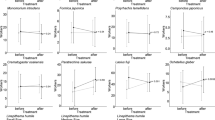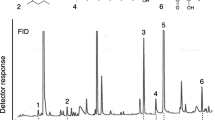Abstract
Trail pheromone disruption of invasive ants is a novel tactic that builds on the development of pheromone-based pest management in other insects. Argentine ant trail pheromone, (Z)-9-hexadecenal, was formulated as a micro-encapsulated sprayable particle and applied against Argentine ant populations in 400 m2 field plots in Hawai‘i Volcanoes National Park. A widely dispersed point source strategy for trail pheromone disruption was used. Traffic rates of ants in bioassays of treated filter paper, protected from rainfall and sunlight, indicated the presence of behaviorally significant quantities of pheromone being released from the formulation for up to 59 days. The proportion of plots, under trade wind conditions (2–3 m s−1), with visible trails was reduced for up to 14 days following treatment, and the number of foraging ants at randomly placed tuna-bait cards was similarly reduced. The success of these trail pheromone disruption trials in a natural ecosystem highlights the potential of this method for control of invasive ant species in this and other environments.





Similar content being viewed by others
References
Aron, S., Beckers, R., Deneubourg, J. L., and Pasteels, J. M. 1993. Memory and chemical communication in the orientation of 2 mass-recruiting ant species. Insect. Soc. 40:369–380.
Cavill, G. W. K., Robertson, P. L., and Davies, N. W. 1979. An Argentine ant Iridomyrmex humilis aggregation factor. Experientia 35:989–990.
Christian, C. E. 2001. Consequences of a biological invasion reveal the importance of mutualism for plant communities. Nature 413:635–639.
Cole, F. R., Medeiros, A. C., Loope, L. L., and Zuehlke, W. W. 1992. Effects of the Argentine ant on arthropod fauna of Hawaiian high-elevation shrubland. Ecology 73:1313–1322.
Dussutour, A., Nicolis, S. C., Shepard, G., Beekman, M., and Sumpter, D. J. T. 2009. The role of multiple pheromones in food recruitment by ants. J. Exp. Biol. 212:2337–2348.
El-sayed, A. M. 2009. The Pherobase: Database of Insect Pheromones and semiochemicals. http://www.pherobase.com Accessed 23 February 2009.
GenStat. 2007. GenStat tenth edition, V 10.1.0.71, Lawes Agricultural Trust, VSN International Ltd.
Gillespie, R. G., and Reimer, N. 1993. The effect of alien predatory ants (Hymenoptera: Formicidae) on Hawaiian endemic spiders (Araneae: Tetragnathidae). Pac. Sci. 47:21–33.
Greenberg, L., Klotz, J. H., and Rust, M. K. 2006. Liquid borate bait for the control of the Argentine ant, Linepithema humile, in organic citrus (Hymenoptera: Formicidae). Fla. Entomol. 89:469–474.
Holway, D. A. 1999. Competitive mechanisms underlying the displacement of native ants by the invasive Argentine ant. Ecology 80:238–251.
Holway, D. A., Lach, L., Suarez, A. V., Tsutsui, N. D., and Case, T. J. 2002. The causes and consequences of ant invasions. Annu. Rev. Ecol. Syst. 33:181–233.
Hooper-bui, L. M., and Rust, M. K. 2000. Oral toxicity of abamectin, boric acid, fipronil, and hydramethylnon to laboratory colonies of Argentine ants (Hymenoptera: Formicidae). J. Econ. Entomol. 93:858–864.
Human, K. G., and Gordon, D. M. 1996. Exploitation and interference competition between the invasive Argentine ant, Linepithema humile, and native ant species. Oecologia 105:405–412.
Human, K. G., and Gordon, D. M. 1997. Effects of Argentine ants on invertebrate biodiversity in northern California. Conserv. Biol. 11:1242–1248.
Hurlbert, S. H. 1984. Pseudoreplication and the design of ecological experiments. Ecol. Monogr. 54:187–211.
Itioka, T., and Inoue, T. 1996. Density-dependent ant attendance and its effects on the parasitism of a honeydew-producing scale insect, Ceroplastes rubens. Oecologia 106:448–454.
Klotz, J., Greenberg, L., and Venn, G. 2000. Evaluation of two hydramethylnon granular baits for control of Argentine ant (Hymenoptera: Formicidae). Sociobiology 36:201–207.
Krushelnycky, P. D., and Reimer, N. J. 1998. Bait preference by the Argentine ant (Hymenoptera: Formicidae) in Haleakala National Park, Hawaii. Environ. Entomol. 27:1482–1487.
Liebherr, J. K., and Krushelnycky, P. D. 2007. Unfortunate encounters? Novel interactions of native Mecyclothorax, alien Trechus obtusus (Coleoptera: Carabidae), and Argentine ant (Linepithema humile, Hymenoptera: Formicidae) across a Hawaiian landscape. J. Insect Conserv. 11:61–73.
Moreno, D. S., Haney, P. B., and Luck, R. F. 1987 Chlorpyrifos and diazinon as barriers to Argentine ant (Hymenoptera: Formicidae) foraging on citrus trees. J. Econ. Entomol. 80:208–214.
Quinn, G. P., and Keough, M. J. 2002. Experimental Design and Data Analysis for Biologists. University Press, Cambridge, UK, pp. 360–371.
Robinson, S. W., and Cherrett, J. M. 1978. The possible use of methyl 4-methylpyrrole-2-carboxylate, an ant trail pheromone, as a component of an improved bait for leaf-cutting ant (Hymenoptera: Formicidae) control. B. Entomol. Res. 68:159–170.
SAS Institute Inc. 2004. SAS/IML 9.1 User’s Guide. Cary, NC: SAS Institute Inc.
Shorey, B. H., Gaston, L. K., Gerber, R. G., Phillips, P. A., and Wood, D. L. 1992 Disruption of foraging by Argentine ants, Iridomyrmex humilis (Mayr) (Hymenoptera: Formicidae), in citrus trees through the use of semiochemicals and related chemicals. J. Chem. Ecol. 18:2131–2142.
Stanley, M., Ward, D., Harris, R., Arnold, G., Toft, R., and Rees, J. 2008. Optimizing pitfall sampling for the detection of Argentine ants, Linepithema humile (Hymenoptera: Formicidae). Sociobiology 51:461–472.
Stelinski, L. L., Mcghee, P., Haas, M., Il'ichev, A. L., and Gut, L. J. 2007. Sprayable microencapsulated sex pheromone formulations for mating disruption of four tortricid species: effects of application height, rate, frequency, and sticker adjuvant. J. Econ. Entomol. 100:1360–1369.
Stringer, L. D., Haywood, J., and Lester, P. J. 2007. The influence of temperature and fine-scale resource distribution on resource sharing and domination in an ant community. Ecol. Entomol. 32:732–740.
Suckling, D. M. 2000. Issues affecting the use of pheromones and other semiochemicals in orchards. Crop Prot. 19:677–683.
Suckling, D. M., and Angerilli, N. P. D. 1996. Pheromone point source distribution affects spike frequency and communication disruption of Epiphyas postvittana (Lepidoptera: Tortricidae). Environ. Entomol. 25:101–108.
Suckling, D. M., Green, S. R., Gibb, A. R., and Karg, G. 1999. Predicting atmospheric concentration of pheromone in treated apple orchards. J. Chem. Ecol. 25:117–139.
Suckling, D. M., Peck, R. W., Manning, L. M., Stringer, L. D., Cappadonna, J., and El-sayed, A. M. 2008. Pheromone disruption of Argentine ant trail integrity. J. Chem. Ecol. 34:1602–1609.
Tanaka, Y., Nishisue, K., Sunamura, E., Suzuki, S., Sakamoto, H., Fukumoto, T., Terayama, M., and Tatsuki, S. 2009. Trail-following disruption in the invasive Argentine ant with a synthetic pheromone component (Z)-9-hexadecenal. Sociobiology 54:139–152.
Tatsuki, S., Teryama, M., Tanaka, Y., and Fukumoto, T. 2005. Behaviour-disrupting agent and behaviour disrupting method of Argentine ant. Patent pub. no. US2005/0209344A1.
Van Vorhis Key, S. E., and Baker, T. C. 1982. Specificity of laboratory trail following by the Argentine ant, Iridomyrmex humilis (Mayr), to (Z)-9-hexadecenal, analogs, and gaster extract. J. Chem. Ecol. 8:1057–1063.
Van Vorhis Key, S. E., Gaston, L. K., and Baker, T. C. 1981. Effects of gaster extract trail concentration on the trail following behaviour of the Argentine ant, Iridomyrmex humilis (Mayr). J. Insect Physiol. 27:363–370.
Vega, S. J., and Rust, M. K. 2001. The Argentine ant—a significant invasive species in agricultural, urban and natural environments. Sociobiology 37:3–25.
Wolf, H., and Wehner, R. 2000. Pinpointing food sources: Olfactory and anemotactic orientation in desert ants Cataglyphis fortis. J. Exp. Biol. 203:857–868.
Wright, R. H. 1964. After pesticides-what? Nature 204:121–125.
Acknowledgements
This work was supported by the New Zealand Foundation for Research Science and Technology (“Managing Invasive Hymenoptera”, contract C06X0601) and the U.S. Geological Survey and National Park Service (“Park-Oriented Biological Support”). Thanks also to “Better Border Biosecurity” (www.b3nz.org). We thank J. Cappadonna, M. Euaparadorn, M. Stelmach, C. Pinzari, G. Ryman, and C. Stephen for help conducting field trials. Suterra LLC kindly provided the formulation at our request. Any use of trade, product, or firm names in this publication is for descriptive purposes only and does not imply endorsement by the U.S. Government.
Author information
Authors and Affiliations
Corresponding author
Rights and permissions
About this article
Cite this article
Suckling, D.M., Peck, R.W., Stringer, L.D. et al. Trail Pheromone Disruption of Argentine Ant Trail Formation and Foraging. J Chem Ecol 36, 122–128 (2010). https://doi.org/10.1007/s10886-009-9734-1
Received:
Revised:
Accepted:
Published:
Issue Date:
DOI: https://doi.org/10.1007/s10886-009-9734-1




